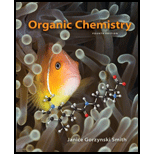
Organic Chemistry-Package(Custom)
4th Edition
ISBN: 9781259141089
Author: SMITH
Publisher: MCG
expand_more
expand_more
format_list_bulleted
Concept explainers
Question
Chapter 11, Problem 11.61P
Interpretation Introduction
Interpretation: A synthesis of
Concept Introduction: The isomers which have same molecular formula but different connectivity of atoms are constitutional isomers.
The replacement or substitution of one
Expert Solution & Answer
Want to see the full answer?
Check out a sample textbook solution
Students have asked these similar questions
What would be the reagents and conditions above and below the arrow that will complete the proposed acetoacetic ester synthesis? If it cannot be done efficiently, then I will choose that answer. There could be 2 or 4 reagents involved. Please provide a detailed explanation and drawings showing how it would proceed with the correct reagents.
For benzene, the ∆H° of vaporization is 30.72 kJ/mol and the ∆S° of vaporization is 86.97 J/mol・K. At 1.00 atm and 228.0 K, what is the ∆G° of vaporization for benzene, in kJ/mol?
The reaction Q(g) + R(g) → Z(l) is shown to be exothermic. Which of the following is true concerning the reaction.
it is spontaneous only at High T, it is spontaneous at low T
it is nonspontaneous at all T
it is spontanrous at all T.
it is non spontaneous only at low T.
Chapter 11 Solutions
Organic Chemistry-Package(Custom)
Ch. 11 - Draw structures for the three alkynes having...Ch. 11 - Prob. 11.2PCh. 11 - Give the IUPAC name for each compound.Ch. 11 - Give the structures corresponding to each of the...Ch. 11 - Prob. 11.5PCh. 11 - Prob. 11.6PCh. 11 - Which bases can deprotonate acetylene? The pKa...Ch. 11 - Draw the organic products formed when each alkyne...Ch. 11 - Prob. 11.9PCh. 11 - Problem 11.9 Draw the products formed when is...
Ch. 11 - Explain the following result. Although alkenes...Ch. 11 - Problem 11.11 Draw the keto tautomer of each...Ch. 11 - Prob. 11.13PCh. 11 - a Draw two different enol tautomers of...Ch. 11 - Prob. 11.15PCh. 11 - Prob. 11.16PCh. 11 - Prob. 11.17PCh. 11 - Problem. 11.17 Show how , and can be used to...Ch. 11 - Prob. 11.19PCh. 11 - Draw the products of each reaction. a. b.Ch. 11 - Prob. 11.21PCh. 11 - Problem 11.21 Use retrosynthetic analysis to show...Ch. 11 - Prob. 11.23PCh. 11 - Give the IUPAC name for each compound. a. b.Ch. 11 - Prob. 11.25PCh. 11 - 11.25 Answer the following questions about...Ch. 11 - Prob. 11.27PCh. 11 - Give the IUPAC name for each alkyne.Ch. 11 - Prob. 11.29PCh. 11 - Which of the following pairs of compounds...Ch. 11 - Prob. 11.31PCh. 11 - 11.30 How is each compound related to A? Choose...Ch. 11 - Prob. 11.33PCh. 11 - Prob. 11.34PCh. 11 - Prob. 11.35PCh. 11 - 11.33 Draw the products formed when is treated...Ch. 11 - Draw the products formed when 3-hexyne is treated...Ch. 11 - Prob. 11.38PCh. 11 - Prob. 11.39PCh. 11 - What alkynes give each of the following ketones as...Ch. 11 - Prob. 11.41PCh. 11 - 11.37 What alkyne gives each compound as the only...Ch. 11 - Prob. 11.43PCh. 11 - Draw the structure of compounds A-E in the...Ch. 11 - Prob. 11.45PCh. 11 - Prob. 11.46PCh. 11 - 11.42 What reactions are needed to convert alcohol...Ch. 11 - Prob. 11.48PCh. 11 - Prob. 11.49PCh. 11 - 11.45 Explain the following statement. Although ...Ch. 11 - Draw a stepwise mechanism for the following...Ch. 11 - Prob. 11.52PCh. 11 - Prob. 11.53PCh. 11 - Prob. 11.54PCh. 11 - Prob. 11.55PCh. 11 - Synthesize each compound from acetylene. You may...Ch. 11 - Prob. 11.57PCh. 11 - Prob. 11.58PCh. 11 - 11.55 Devise a synthesis of the ketone, , from ...Ch. 11 - 11.56 Devise a synthesis of each compound using ...Ch. 11 - Prob. 11.61PCh. 11 - Prob. 11.62PCh. 11 - 11.60 Draw a stepwise mechanism for the following...Ch. 11 - Draw a stepwise mechanism for the following...Ch. 11 - Prob. 11.65PCh. 11 - Write a stepwise mechanism for each of the...Ch. 11 - Prob. 11.67PCh. 11 - 11.65 Explain why an optically active solution of ...
Knowledge Booster
Learn more about
Need a deep-dive on the concept behind this application? Look no further. Learn more about this topic, chemistry and related others by exploring similar questions and additional content below.Similar questions
- The reaction Q(g) + R(g) → Z(l) is shown to be exothermic. Which of the following is true concerning the reactionarrow_forwardWhich of the following has the largest standard molar entropy, S° (298.15 K) He H2 NaCl KBr Hgarrow_forwardWhich of the following is true for a particular reaction if ∆G° is -40.0 kJ/mol at 290 K and –20.0 kJ/mol at 390 K?arrow_forward
- Choose the major product of the reaction with correct regio- and stereochemistry. Br2 H₂O O "Br Br & O 'Br OH Br 吡 O OH OH Br "OH Brarrow_forwardSelect the major product of the following reaction. & Br (CH)CONa (CH₂),COH 0 OC(CH) O &arrow_forwardDraw the products of the hydrolysis reaction between the ester molecule and water. Determine the products of the following reaction.arrow_forward
arrow_back_ios
SEE MORE QUESTIONS
arrow_forward_ios
Recommended textbooks for you
 Organic ChemistryChemistryISBN:9781305580350Author:William H. Brown, Brent L. Iverson, Eric Anslyn, Christopher S. FootePublisher:Cengage Learning
Organic ChemistryChemistryISBN:9781305580350Author:William H. Brown, Brent L. Iverson, Eric Anslyn, Christopher S. FootePublisher:Cengage Learning

Organic Chemistry
Chemistry
ISBN:9781305580350
Author:William H. Brown, Brent L. Iverson, Eric Anslyn, Christopher S. Foote
Publisher:Cengage Learning